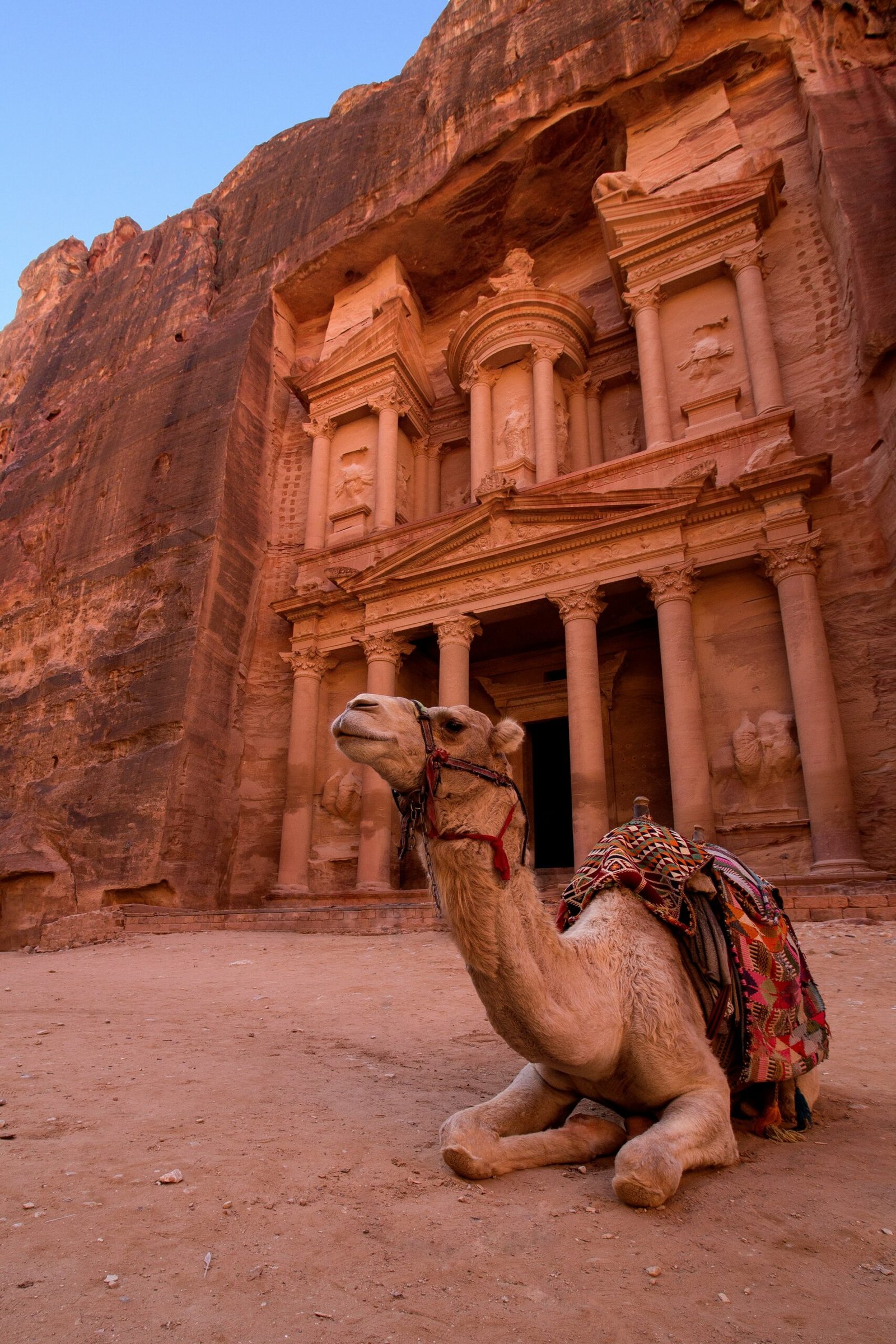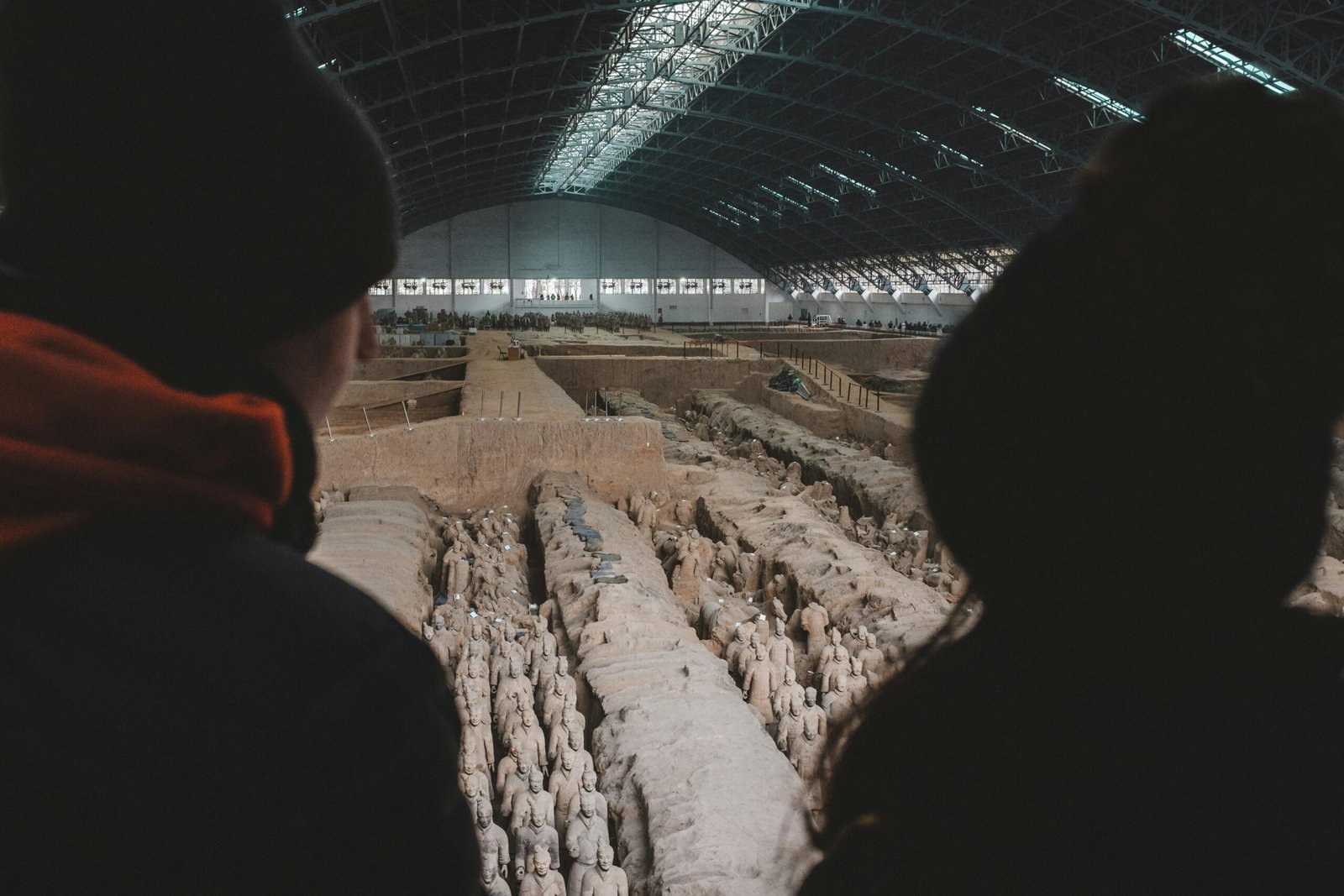
Petra, located in the southwestern part of Jordan, is an ancient city that dates back to the 4th century BC. It was once the capital of the Nabataean Kingdom and served as an important trading hub for the region. The city is carved into the rose-colored sandstone cliffs, giving it a unique and otherworldly appearance. The intricate rock-cut architecture, the grandeur of the Treasury, and the vastness of the site make Petra a truly mesmerizing destination.
As you enter Petra through the narrow and winding Siq, a narrow gorge flanked by towering cliffs, you can’t help but feel a sense of wonder and anticipation. The Siq gradually opens up to reveal the Treasury, one of Petra’s most iconic and well-preserved structures. This impressive facade, with its intricate carvings and towering columns, is a testament to the architectural prowess of the Nabataeans.
Exploring further into Petra, you will discover a myriad of tombs, temples, and other ancient structures. The Royal Tombs, adorned with elaborate facades and intricate details, offer a glimpse into the grandeur of the Nabataean civilization. The Monastery, another highlight of Petra, is a massive structure perched high on a hilltop, offering breathtaking views of the surrounding landscape.
Aside from its architectural marvels, Petra also boasts stunning natural beauty. The rugged desert landscape, the towering cliffs, and the vibrant hues of the sandstone create a picturesque backdrop for the ancient city. The colors change throughout the day, from warm golden tones in the morning to fiery reds at sunset, adding to the enchantment of the site.
Visiting Petra is not just about admiring its beauty and marveling at its history; it’s also about immersing yourself in the rich culture of Jordan. The local Bedouin community, who have inhabited the area for centuries, offer a warm welcome to visitors, sharing their traditions, stories, and hospitality. You can experience their way of life by staying in a Bedouin camp, enjoying traditional meals, and participating in cultural activities.
Whether you are a history buff, an architecture enthusiast, or simply a traveler seeking a unique and awe-inspiring experience, Petra is a destination that will leave you in awe. Its ancient wonders, natural beauty, and cultural richness make it a truly unforgettable place to visit. So, pack your bags and embark on a journey to Petra, where the past comes to life and the beauty of the desert captivates your soul.
Since its rediscovery, Petra has become a UNESCO World Heritage Site and one of the most visited tourist destinations in the Middle East. The city’s unique blend of natural beauty and architectural marvels has made it a symbol of Jordan’s rich history and cultural heritage.
One of the most iconic features of Petra is its rock-cut architecture. The Nabateans were skilled craftsmen who carved elaborate facades into the sandstone cliffs, creating stunning tombs, temples, and dwellings. The most famous of these structures is the Treasury, also known as Al-Khazneh, which is adorned with intricate carvings and served as a mausoleum for a Nabatean king.
Exploring Petra is like stepping back in time. As visitors make their way through the narrow siq, a winding canyon that leads to the city, they are transported to an ancient world filled with history and mystery. Along the way, they can marvel at the impressive engineering feats of the Nabateans, such as the water channels and cisterns that allowed the city to thrive in the arid desert environment.
But Petra is more than just a collection of ancient ruins. It is a living testament to the resilience and ingenuity of the Nabateans. The city’s strategic location made it a hub for trade and cultural exchange, and its inhabitants were known for their skills in agriculture, pottery, and textile production.
Today, visitors to Petra can immerse themselves in the rich history of the city by exploring the archaeological sites, attending cultural events, and learning about the Nabatean civilization at the Petra Museum. The city also offers a range of modern amenities, including hotels, restaurants, and souvenir shops, ensuring that visitors have a comfortable and enjoyable experience.
However, the popularity of Petra has also presented some challenges. The influx of tourists has put a strain on the fragile ecosystem of the site, leading to concerns about conservation and sustainability. Efforts are being made to mitigate the impact of tourism through measures such as visitor limits, waste management systems, and education programs.
Despite these challenges, Petra continues to inspire awe and fascination in all who visit. Its timeless beauty and historical significance make it a must-see destination for travelers seeking a glimpse into the past. Whether exploring the ancient ruins or simply admiring the stunning landscapes, a visit to Petra is an unforgettable experience that will leave a lasting impression.
The architecture of Petra goes beyond just the Treasury and the Monastery. As you explore the ancient city, you will come across numerous other structures that showcase the ingenuity and creativity of the Nabateans. One such example is the Great Temple, which was the largest freestanding building in Petra. Unfortunately, much of it has been destroyed over time, but the remnants still give us a glimpse into its former glory.
Aside from the monumental buildings, Petra is also home to a vast number of houses, tombs, and other smaller structures. These dwellings were carved directly into the cliffs, creating a unique and efficient use of space. The houses feature intricate facades and interior designs, with some even having multiple levels. Walking through the narrow streets of Petra, you can imagine what life was like for the Nabateans who called this city home.
One of the most fascinating aspects of the architecture in Petra is the water management system. Despite being located in a desert region, the Nabateans were able to create an elaborate network of channels, cisterns, and dams to collect and distribute water throughout the city. This engineering marvel allowed Petra to thrive and sustain a large population.
Another noteworthy feature of Petra’s architecture is the integration of different cultural influences. As a trading hub, Petra was exposed to various civilizations, including the Greeks, Romans, and Egyptians. This cultural exchange is reflected in the architectural styles and motifs found in the city. For example, the Nabateans incorporated elements of Hellenistic and Roman architecture into their own designs, resulting in a unique blend of styles.
Overall, the architecture of Petra is a testament to the creativity, skill, and resourcefulness of the Nabateans. Their ability to carve magnificent structures out of solid rock and create a thriving city in the desert is truly awe-inspiring. Today, Petra stands as a UNESCO World Heritage Site and continues to captivate visitors from around the world with its architectural wonders.
Continuing your exploration of Petra, you’ll find that there is so much more to see beyond the Treasury. As you continue walking through the ancient city, you’ll come across a multitude of tombs, temples, and other structures that showcase the architectural brilliance of the Nabateans.
One notable site to visit is the Great Temple, an impressive structure that was once the center of religious and social life in Petra. Its grand columns and intricate carvings are a testament to the advanced engineering and artistic skills of the Nabateans.
As you wander further into the city, you’ll stumble upon the Street of Facades, a row of monumental tombs that were carved into the cliff face. These tombs served as the final resting places for the wealthy and powerful individuals of Petra, and their elaborate facades are a sight to behold.
For those with a sense of adventure, a hike up to the High Place of Sacrifice is highly recommended. This elevated platform offers panoramic views of the entire city and surrounding desert landscape. It’s a perfect spot to take a break, soak in the breathtaking scenery, and reflect on the rich history that surrounds you.
If you’re feeling adventurous, you can also explore some of the lesser-known trails that lead to hidden gems within Petra. The Wadi Farasa trail, for example, takes you through a narrow canyon and leads to a series of rock-cut tombs and caves. It’s a quieter and less crowded area, allowing you to experience Petra in a more intimate and personal way.
After a day of exploration, you can unwind and relax at one of the local restaurants or cafes located near the main entrance of Petra. Indulge in traditional Jordanian cuisine, such as mansaf (a delicious lamb dish), or sip on a cup of aromatic Bedouin tea while enjoying the sunset. The hospitality of the locals is warm and welcoming, and you’ll find yourself immersed in the rich culture and traditions of the region.
As you leave Petra, you’ll carry with you memories of an extraordinary journey through time. The ancient city of Petra is a testament to the ingenuity and artistic prowess of the Nabateans, and it’s an experience that will stay with you long after you’ve returned home.
Tips for Visiting Petra
Here are a few tips to help you make the most of your visit to Petra:
- Wear comfortable shoes: Petra is a vast site, and you’ll be doing a lot of walking. Make sure to wear comfortable shoes that can handle uneven terrain. Consider wearing hiking shoes or sturdy sneakers that provide good support and traction. The paths in Petra can be rocky and uneven, so it’s important to have footwear that will keep your feet comfortable and protected throughout your visit.
- Bring plenty of water: The desert heat can be intense, especially during the summer months. Stay hydrated by bringing a refillable water bottle. It’s recommended to bring at least 1-2 liters of water per person, depending on the duration of your visit. There are also water fountains available at certain points in Petra where you can refill your bottle, but it’s always a good idea to have extra water on hand.
- Visit early or late in the day: Petra can get crowded, especially during peak tourist season. To avoid the crowds, consider visiting early in the morning or late in the afternoon. The site opens at 6 am, so arriving early will not only give you a chance to explore before the crowds arrive, but also allow you to witness the stunning sunrise over the Treasury. If you prefer a quieter experience, visiting during the late afternoon can be a great option as well. The site closes at 6 pm, giving you ample time to explore before it gets dark.
- Engage with the local guides: The local guides in Petra are knowledgeable and passionate about the history of the site. Hiring a guide can enhance your experience and provide you with valuable insights. They can point out hidden details, share fascinating stories, and help you navigate the site more efficiently. Additionally, they can take you off the beaten path to lesser-known areas of Petra, giving you a unique perspective on this ancient city.
- Take your time: Petra is not a place to rush through. Allow yourself plenty of time to explore and soak in the beauty of this ancient city. There are countless wonders to discover, from the iconic Treasury to the Monastery and the Royal Tombs. Take the time to wander through the narrow Siq, marvel at the intricate rock-cut architecture, and appreciate the stunning natural surroundings. Plan your visit with enough time to fully immerse yourself in the history and atmosphere of Petra.
Following these tips will ensure that you have a memorable and enjoyable visit to Petra. Remember to be respectful of the site and its cultural significance, and take the time to appreciate the incredible history and craftsmanship that went into creating this UNESCO World Heritage site.



